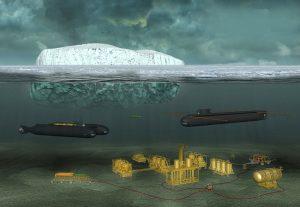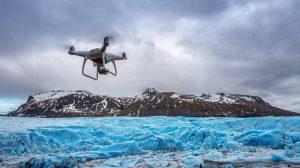
Photo: Icebreakers already have landing pads for helicopters / TASS / Vladimir Smirnov
What kind of drones are needed for ice reconnaissance?
In 2024, Rosatom State Corporation will receive a subsidy in the amount of 300 million rubles from the federal budget for the purchase of the first unmanned aircraft systems (UAS) for monitoring the ice situation on the Northern Sea Route (NSR). Maxim Kulinko, Deputy Director of the NSR Rosatom, told Vedomosti about this.
According to him, the company plans to purchase two UAS with these funds, each of which will consist of two drones, a communication system and control systems. The UAS will provide real-time data on the ice situation. The incoming data will be processed on a single digital platform, which Rosatom is currently creating for the NSR.
In the future, the state corporation plans to install one UAS for each icebreaker. The UAS will become part of the overall ice reconnaissance system, which will also use on-board measuring systems and satellite data.
“We need to increase the data sources that are necessary for safe navigation. There is nothing ready on the market that could be bought and piloted in the Arctic right now. My colleagues and I are doing innovative work,” Kulinko explained. He stressed that there are no imported analogues of such machines “in terms of payload and algorithms” for operation in the Arctic conditions on the market today.
Drones must be resistant to icing, radiation from the navigation systems of nuclear icebreakers, withstand wind loads up to 12 m/s during vertical takeoff and up to 18 m/s on the march. On-board measuring systems will allow automated measurement of the thickness of ice at the location of the vessel and laser lidars to measure the compression of ice in the channels behind the vessel.
Foreign operators launch drones from ships, but use them “in milder” climatic conditions. The software for the project is being developed by the Moscow Institute of Physics and Technology (MIPT), the manufacturer of the machine itself is not disclosed at Rosatom. MIPT not only develops software for the project, but also “connects all software and hardware elements into a single complex.”
The synthesis of radar images from a drone is more difficult to process satellite data, since drones move along an unstable trajectory and are subject to wind gusts. The forecast of the development of the ice situation requires detailed modeling of processes in the atmosphere, ocean thickness, and in the ice itself.
How the Northern Sea Route is being developed

Photo: Phaeton drone at the exhibition / Alexey Zakvasin
The NSR should ensure reliable and safe transportation of goods and goods for residents of the Far North, as well as for the export of natural resources (oil, LNG, coal, metals). The government’s development plan for the NSR until 2035 assumes an increase in cargo traffic in 2024 to 80 million tons, in 2030 to 150 million tons, in 2035 to 220 million tons.
By 2030, it is planned to establish year-round navigation. Currently, navigation in the eastern sector of the NSR is impossible in winter without icebreaking wiring (ice thickness reaches 3 m). There are more than 40 icebreakers in operation in Russia. Atomflot has eight nuclear icebreakers, and Rosmorport operates, according to the agency, more than 30 diesel-electric icebreakers, including icebreaking tugs.
Mikhail Lipatov, CEO of the Mine company, notes that to measure the thickness of the ice, the drone needs to be equipped with a radar weighing 20-80 kg. “We need a reliable machine capable of taking off and landing on the deck of an icebreaker in difficult weather conditions,” he says.
The expert considers a tiltrotor with a variable wing geometry to be the “most optimal” type of drone for such a project: it is compact and can easily be placed on a ship, can take off and land vertically, has a longer flight range and is less demanding of an on-board computer than a helicopter-type drone.
Mikhail Grigoriev, Director of the Gekon consulting company, considers the development of UAS necessary in conditions of a shortage of satellite data. Satellite groupings of the United States and European countries currently do not provide Russian users with access to information, he recalls.
“The absolute advantage of drones is their short range. Hypothetically, they can be run at any time as needed. And satellite data is received at best several times a day,” Grigoriev says. The expert notes that in order to develop UAS, several difficult tasks will need to be solved – in particular, safe landing “in the most difficult conditions of the Far North.”
By German Kostrinsky, Anastasia Kurasheva, Alexander Volobuev


